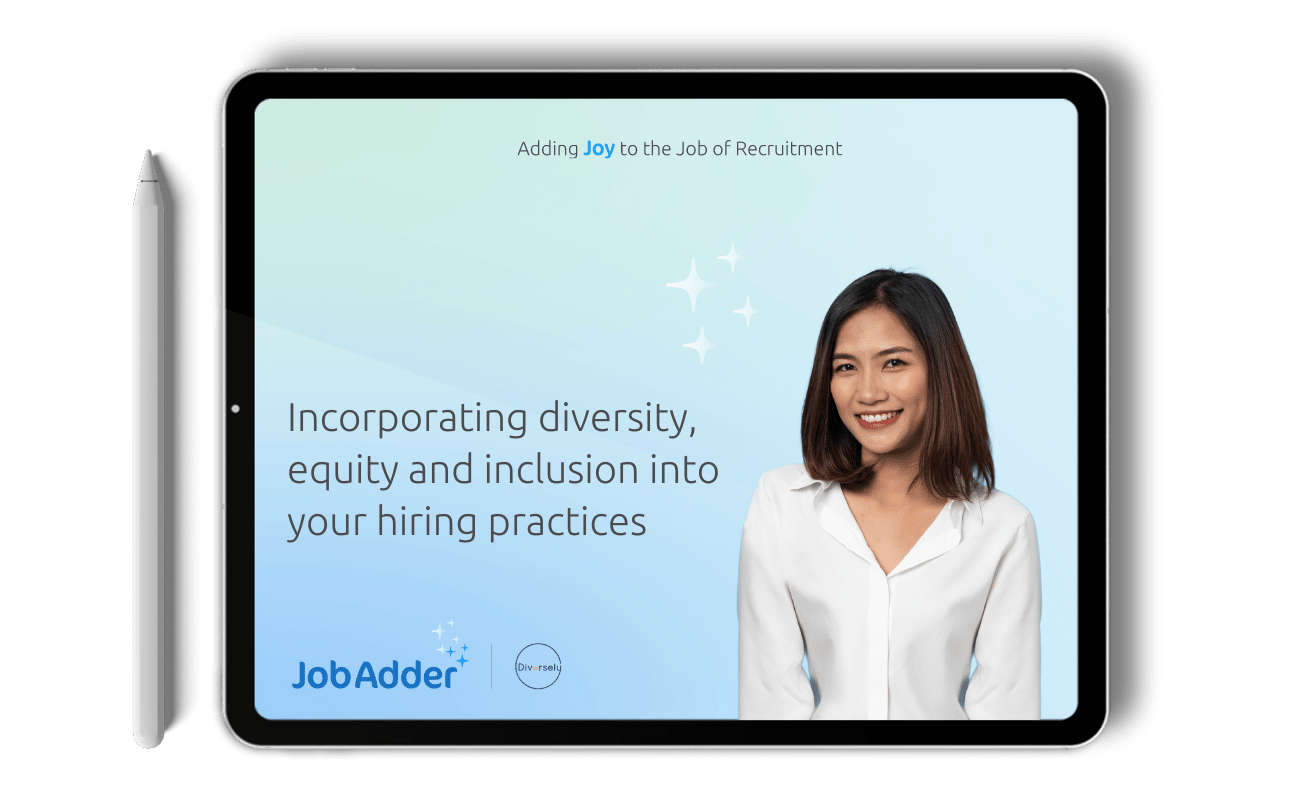Building a diverse workforce is not just a nice-to-have. It’s the right thing to do and it improves team satisfaction, increases productivity, drives innovation and reduces staff turnover.
To build a diverse workforce, it’s essential that we remove bias from the hiring and selection process: and one crucial component of this is anonymising applicant resumes and CVs.
At Diversely, our applicant anonymiser tool removes identifiable characteristics from CVs and resumes to ensure a round of blind screening. As a JobAdder partner, we thought we’d share some of our users’ frequently asked questions and our answers on the JobAdder blog.
DOWNLOAD FREE eBOOK: Incorporating diversity, equity and inclusion into your hiring practices
A list of frequently heard concerns and questions
Here are some frequently asked questions and concerns about anonymising applicant resumes and CVs:
- Blind hiring: Is anonymising the same as blind hiring? What’s exactly anonymised from a resume or CV?
- Time and effort: Won’t it take a lot of time and effort for the recruitment teams to anonymise applicants’ resumes and CVs?
- The seniority of the applicant: Without a date of birth, age or years of experience, how will I know if they’re senior enough for the position?
- Sorting and filtering: When I have hundreds of applicants I use schools or universities as a way to filter, how should I do that now?
- Under-represented groups: What if I want to make a conscious effort to shortlist applicants from under-represented backgrounds?
- Applicant journey and experience: Wouldn’t applicants mind us anonymising their resume or CV, especially if they’ve put time and effort into writing it just so?
- Why bother: If I’m going to meet the applicants anyway for an interview, why bother with anonymised profiles at this stage?
In the next section, let’s dive into each one of these questions one at a time. We’d also love to hear if you have any further questions and concerns! Please reach out to info@diversely.io
Is anonymising the same as blind hiring?
We don’t particularly like the term blind hiring and that’s why we use anonymisation instead. It alludes to the same concept though, ensuring a fair and impartial experience for applicants based on their skills and experience, instead of their identity or background. At Diversely, we allow applicants to apply with their LinkedIn profile or resume/CV document. Our anonymiser tool takes their original profile or document and creates a new clean version without any identifiable data or characteristics.
We remove identifiable and irrelevant data like:
- Names and photos: These can elude to gender, race and age of applicants, none of which should matter for (the great majority of) jobs. Outright discrimination is relatively rare, but unfortunately still exists, however unconscious bias is the greater challenge.
- Date of birth, age and years of experience: This unnecessarily might exclude some applicants. For instance, we find for tech roles, applicants 35 years and older are disregarded because “they’ll not be able to pick up new skills as quickly [as younger applicants]”, whereas for many professional services positions they will outright exclude any applicant with less than X years of experience.
- Schools and university names: We find many recruiters and hiring managers will only want to hire from specific ‘top tier’ schools, unnecessarily disregarding qualified and capable applicants from non-top-tier schools and usually from lower socio-economic backgrounds.
- Gendered pronouns and ethnic background references: These are removed across the resume/CV. When applicants describe themselves in the third person, they might use “he/his or she/her, we replace this with they/them to avoid gender bias. The same applies to an applicant who might describe themselves as Dutch/Turkish/Malay professional.
- Contact details like email addresses, phone numbers and LinkedIn profiles: These might give away information about the applicant which could unduly influence the first screening process.
The applicant anonymiser tool ensures one round of blind screening. After you’ve selected the most relevant applicants based on skills and experience, you’ll be able to get all of their original and identifiable data. It’s up to you to take applicants forward in a fair and unbiased assessment and interviewing process.
Won’t it take a lot of time and effort to anonymise profiles?
Very valid questions, as we understand your recruiters, talent acquisition teams and hiring managers are busy enough as it is.
While taking a black marker to resumes/CVs might indeed be quite time-consuming, at Diversely we do the heavy lifting for you. All applicants applying to your jobs through our system will automatically be anonymised, with no effort required from your team.
Of course, we’ll save all applicants’ details (including name, DoB and contact details) as well as their original resumes/CVs for you to use across the rest of the hiring process. You can extract that data from our system, or if integrated have a feed into your JobAdder account.
How will I know if they’re senior enough for the position?
We know that age and/or years of experience are often seen as a good measure of seniority. But it’s good to be aware that this is just a proxy. Someone with four years of (intense and high growth) experience might be just as capable or even more so than someone with eight years of experience.
It’s much more useful to think of the specific experience you’re looking for. For example, would you expect applicants to have:
- Managed a small team or a full department?
- Been responsible for a profit centre or cost centre?
- Independently led or been a contributor to a project of certain complexity?
Getting that kind of information from an applicant’s profile is a much more powerful measure of experience, compared to age or years in a role. And as a next step, assessing those skills and experiences with relevant case studies and tests will truly help you find the best candidate for the job.
Want to improve diversity in your recruitment? Access our free eBook with Diversely now.

How do I quickly sift through/ filter hundreds of profiles?
This is a question we get a lot during demos of the applicant anonymiser. And it often makes me laugh. My usual response: Well, how do you do that in your current process?
Usually, the answer to that question involves a lot of proxies and biases. The long and the short of it is that they’ll select (and therefore also exclude) applicants based on:
- The schools/universities they went to
- Their location (proximity to the office)
- Years of experience or in a certain role
- Previous employers (ex-company names)
- Marital status and related assumptions (child-bearing age)
All we can say about this is that it will definitely NOT help you to increase your diversity. You’ll continue to funnel the same type of applicants into your organisation, and propagate the exact biases we’re trying to reduce.
So what’s the best way to get through? Open each profile and read. At Diversely, the anonymised profile has a simple and repetitive structure, which makes it quick and easy to compare applicant profiles. We’ve also built in a skill highlighter, which flags all the key skills and provides recruiters and hiring managers with a bird’s eye view of the profile.
What if I want to make a conscious effort for minorities?
At Diversely, we believe in providing everyone with a fair and equal opportunity and hiring the best person for the job. We also recognise that there has been a lot of unfair and unequal treatment in the past which has led to significant (gender, racial, generational, socio-economic, disability) gaps in the workplace. If anything, COVID-19 has increased inequality and broadened these gaps. A recent publication from WEF shows that, at the current pace, it will take 136 years to bridge the gender gap alone.
We can therefore greatly relate to recruiters and hiring managers who want to give under-represented (minority) groups an extra push into their organisation. The question is, what is the right way to go about this? We generally promote two ways:
- Ensuring a broad and diverse pipeline of talent and applicants enter your hiring funnel: If you ensure significant representation across your talent pool, the chances are that a significant number (if qualified) will be shortlisted and finally hired. This is something you can track too!
- Screen, record your thoughts and rate anonymised applicant profiles: Decide who you’d definitely wish to shortlist and who you definitely wouldn’t. For some of those in the middle, let’s call them the “maybes”, we have a solution. Our Diversely indicator flags under-represented groups from the anonymised list. It doesn’t tell you which group they belong to, whether gender, age, race or other, but simply allows you to give them the benefit of the doubt.
This way you get the best of both worlds, shortlisting the best applicants for the job based on an anonymised screening while still giving under-represented groups a push into the next round.
How do applicants experience this way of applying?
From an applicant’s perspective, not that much changes when it comes to applying. They can simply apply with their LinkedIn profile or by uploading their PDF resume/CV, Diversely does the rest. We inform applicants during their application that we will be anonymising their profile to ensure a fair and equal opportunity and show them an example of what that anonymised profile will look like.
In fact, applicant feedback has been very positive. Results from our survey, as well as sample interviews with applicants (especially those from under-represented groups), show that they appreciate the ease of application and the philosophy behind the anonymisation. Diversely makes it quick and easy for applicants to apply, without answering too many questions. It’s all about being inclusive, and frankly, not everyone has the time to spare going through a lengthy application process.
If I’m going to see their details anyway, why bother?
Having one round of anonymised selection will help create awareness for unconscious bias (especially if you use A/B testing as some of our clients have started to do) and will ensure that the applicants being interviewed have gone through one round of bias-free reviews.
Of course, the journey shouldn’t stop here, there are loads of other measures to put in place to ensure your applicants continue to experience a fair and equal opportunity to be hired. Check out our blog on this topic here.
An example of an anonymised application profile
All identifiable characteristics have been removed automatically, just leaving what’s relevant to decide on the applicant’s fit for the job requirement.
The general about section:

The work experience section:

The education section:

The skills summary section:

“When it comes to screening and short-listing applicants we see so much potential for bias and removing unnecessary data helps us to focus on what really matters – the university names are a great example.”
— Michelle Chan, Dun and Bradstreet
We like to host guest blogs from our expert integration partners so you’ll find that this blog was originally published by Diversely here.




